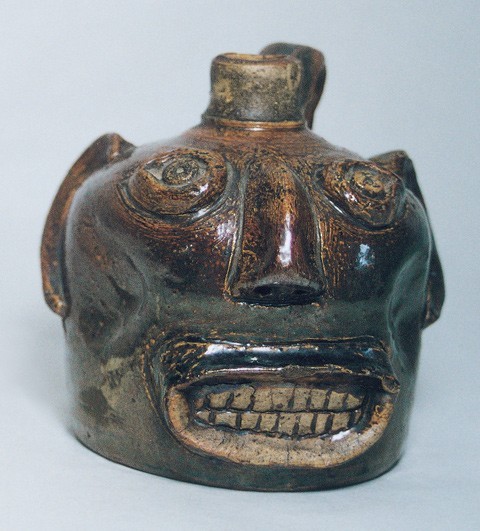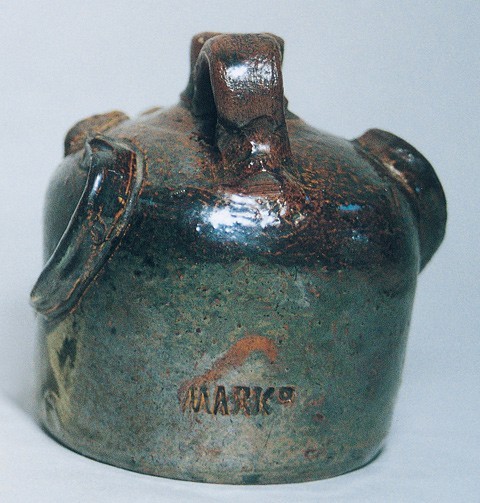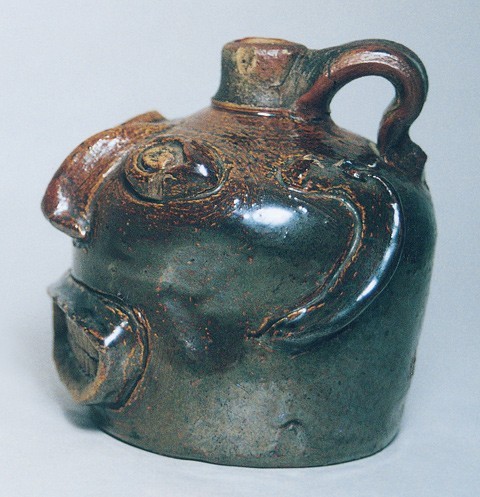
Face jug, Mark Baynham,
Trenton, South Carolina, ca. 1900. Albany-slipped stoneware. H. 5". (All photos, courtesy Robert Girouard.) The style shows distinct connections with the face vessels made by African slave potters working in the area since the late 1850s.

Back view of the face jug illustrated in fig. 1. The maker’s stamp, MARK• contains a distinct period after his name. This period appears to be an addition to the stamp from earlier versions, and imitates the style of his father’s pottery, Joseph Baynham, which is marked JGB•.

Side view of the face jug illustrated in fig. 1. This view reveals Mark Baynham’s distinctive tubular neck and curvaceous neck to shoulder handle.
In 1996, the Georgia Archaeological Institute (GAI) began researching Joseph Gregory Baynham, a potter who worked in the Edgefield alkaline-glaze tradition near Trenton, South Carolina, in the 1870s. Begun in 1997, excavations of his pottery production site have surprisingly revealed two sites: the 1870s Joseph Baynham site, situated above the older, ca. 1862–1872, Lewis Miles site.[1] Differences in styles, glazes, and fabrics have made it possible to attribute the hundreds of vessels recovered to different periods of manufacture, and even to some of the potters who worked there.
In 2002, on the Internet site eBay.com, a small Albany-slipped stoneware face jug was auctioned (fig. 1). The exterior above the base was stamped “MARK•” (fig. 2), and I instantly recognized the marker’s mark of Mark Baynham! As well, I could see that the diminutive vessel exhibited Baynham’s distinctive tubular neck and gracefully curved neck-to-shoulder handle (fig. 3).
Born in 1878, Mark was the eldest son of Joseph Baynham, and by age nineteen was making his own pottery at his father’s Trenton works.[2] During excavations of the site, his stamp “MARK” was found on three whole jugs in a gully filled with intact wasters.[3] A fourth documented example is in a private collection. Now the fifth known complete “MARK” jug, the eBay vessel, is the first evidence that he made face jugs.
Undoubtedly, slave-made face jugs manufactured in Edgefield and dating from the late 1850s influenced Mark, as his jug appears to be directly modeled on those examples. The ears and nose are applied, as are the lips and eyelids. The eyes and teeth are modeled into the unglazed body of the vessel, the teeth being especially reminiscent of the African style vessels. Though not of kaolin as are the African-American face jugs, the teeth and eyeballs are unglazed, implying very careful application of the glaze, again copying the African-American practice.
Fortunately, GAI is continuing investigations at the Baynham/Miles complex site. Artifact studies are enabling scholars to confidently identify products from the site in the archaeological record as well as in aboveground collections. As this research continues, more remarkable new discoveries are sure to follow.
Mark M. Newell, Ph.D.
Director
Georgia Archaeological Institute
<mnewell@yahoo.com>
Mark M. Newell, “A Spectacular Find at the Joseph Gregory Baynham Pottery Site,” in Ceramics in America, edited by Robert Hunter (Hanover, N.H.: University Press of New England for the Chipstone Foundation, 2001), pp. 229–32.
Nancy Baynham, Baynham: A South Carolinian Family (Augusta, Ga.: Hamburg Press, 2000).v
Newell, “A Spectacular Find,” p. 232.
